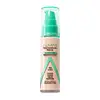What's inside
What's inside
 Key Ingredients
Key Ingredients

 Benefits
Benefits

 Concerns
Concerns

 Ingredients Side-by-side
Ingredients Side-by-side

Water
Skin ConditioningButylene Glycol
HumectantGlycerin
HumectantPEG-150 Distearate
EmulsifyingPolysorbate 80
EmulsifyingNiacinamide
SmoothingRosmarinus Officinalis Leaf Water
MaskingMelissa Officinalis Flower/Leaf/Stem Water
Skin ConditioningMentha Piperita Leaf Water
Skin ConditioningSodium Hyaluronate
HumectantSodium Ascorbyl Phosphate
AntioxidantMenthol
MaskingPentylene Glycol
Skin ConditioningPropylene Glycol
HumectantPEG-240/Hdi Copolymer Bis-Decyltetradeceth-20 Ether
StabilisingPEG-40 Hydrogenated Castor Oil
EmulsifyingPhenoxyethanol
PreservativeEthylhexylglycerin
Skin ConditioningCaprylyl Glycol
EmollientDisodium EDTA
Trideceth-9
Emulsifying1,2-Hexanediol
Skin ConditioningCI 42090
Cosmetic ColorantCI 19140
Cosmetic ColorantWater, Butylene Glycol, Glycerin, PEG-150 Distearate, Polysorbate 80, Niacinamide, Rosmarinus Officinalis Leaf Water, Melissa Officinalis Flower/Leaf/Stem Water, Mentha Piperita Leaf Water, Sodium Hyaluronate, Sodium Ascorbyl Phosphate, Menthol, Pentylene Glycol, Propylene Glycol, PEG-240/Hdi Copolymer Bis-Decyltetradeceth-20 Ether, PEG-40 Hydrogenated Castor Oil, Phenoxyethanol, Ethylhexylglycerin, Caprylyl Glycol, Disodium EDTA, Trideceth-9, 1,2-Hexanediol, CI 42090, CI 19140
Water
Skin ConditioningCyclopentasiloxane
EmollientGlycerin
HumectantCyclohexasiloxane
EmollientNylon-12
Trimethylsiloxysilicate
EmollientPEG/PPG-18/18 Dimethicone
EmulsifyingDimethicone
EmollientCetyl PEG/PPG-10/1 Dimethicone
EmulsifyingBoron Nitride
AbsorbentIsodecyl Neopentanoate
EmollientCopernicia Cerifera Cera
EmollientSalicylic Acid
MaskingAloe Barbadensis Leaf Juice
Skin ConditioningMaris Sal
Skin ConditioningAlpha-Glucan Oligosaccharide
CleansingCaprylyl Glycol
EmollientDimethicone/Bis-Isobutyl PPG-20 Crosspolymer
EmollientHydrolyzed Vegetable Protein
Skin ConditioningLactobacillus
Skin ConditioningLecithin
EmollientMaltodextrin
AbsorbentPEG-10 Dimethicone
Skin ConditioningPerlite
AbsorbentPolymnia Sonchifolia Root Juice
Skin ConditioningTetrasodium EDTA
Tocopheryl Acetate
AntioxidantTriethoxycaprylylsilane
Trisiloxane
Skin ConditioningPhenoxyethanol
PreservativeIron Oxides
CI 77492
Cosmetic ColorantCI 77499
Cosmetic ColorantCI 77891
Cosmetic ColorantZinc Oxide
Cosmetic ColorantWater, Cyclopentasiloxane, Glycerin, Cyclohexasiloxane, Nylon-12, Trimethylsiloxysilicate, PEG/PPG-18/18 Dimethicone, Dimethicone, Cetyl PEG/PPG-10/1 Dimethicone, Boron Nitride, Isodecyl Neopentanoate, Copernicia Cerifera Cera, Salicylic Acid, Aloe Barbadensis Leaf Juice, Maris Sal, Alpha-Glucan Oligosaccharide, Caprylyl Glycol, Dimethicone/Bis-Isobutyl PPG-20 Crosspolymer, Hydrolyzed Vegetable Protein, Lactobacillus, Lecithin, Maltodextrin, PEG-10 Dimethicone, Perlite, Polymnia Sonchifolia Root Juice, Tetrasodium EDTA, Tocopheryl Acetate, Triethoxycaprylylsilane, Trisiloxane, Phenoxyethanol, Iron Oxides, CI 77492, CI 77499, CI 77891, Zinc Oxide
 Reviews
Reviews

Ingredients Explained
These ingredients are found in both products.
Ingredients higher up in an ingredient list are typically present in a larger amount.
Caprylyl Glycol is a humectant and emollient, meaning it attracts and preserves moisture.
It is a common ingredient in many products, especially those designed to hydrate skin. The primary benefits are retaining moisture, skin softening, and promoting a healthy skin barrier.
Though Caprylyl Glycol is an alcohol derived from fatty acids, it is not the kind that can dry out skin.
This ingredient is also used as a preservative to extend the life of products. It has slight antimicrobial properties.
Learn more about Caprylyl GlycolGlycerin is already naturally found in your skin. It helps moisturize and protect your skin.
A study from 2016 found glycerin to be more effective as a humectant than AHAs and hyaluronic acid.
As a humectant, it helps the skin stay hydrated by pulling moisture to your skin. The low molecular weight of glycerin allows it to pull moisture into the deeper layers of your skin.
Hydrated skin improves your skin barrier; Your skin barrier helps protect against irritants and bacteria.
Glycerin has also been found to have antimicrobial and antiviral properties. Due to these properties, glycerin is often used in wound and burn treatments.
In cosmetics, glycerin is usually derived from plants such as soybean or palm. However, it can also be sourced from animals, such as tallow or animal fat.
This ingredient is organic, colorless, odorless, and non-toxic.
Glycerin is the name for this ingredient in American English. British English uses Glycerol/Glycerine.
Learn more about GlycerinPhenoxyethanol is a preservative that has germicide, antimicrobial, and aromatic properties. Studies show that phenoxyethanol can prevent microbial growth. By itself, it has a scent that is similar to that of a rose.
It's often used in formulations along with Caprylyl Glycol to preserve the shelf life of products.
Water. It's the most common cosmetic ingredient of all. You'll usually see it at the top of ingredient lists, meaning that it makes up the largest part of the product.
So why is it so popular? Water most often acts as a solvent - this means that it helps dissolve other ingredients into the formulation.
You'll also recognize water as that liquid we all need to stay alive. If you see this, drink a glass of water. Stay hydrated!
Learn more about Water